Date£º
2016-10-13 15:49 Source£º
www.decanterchina.com Author:
LI Demei Translator:
Sylvia Wu
The 2016 harvest of Xinjiang has been a ¡®mixed success¡¯, with regions having to abandon part of their yields due to disease, said Professor Li Demei.
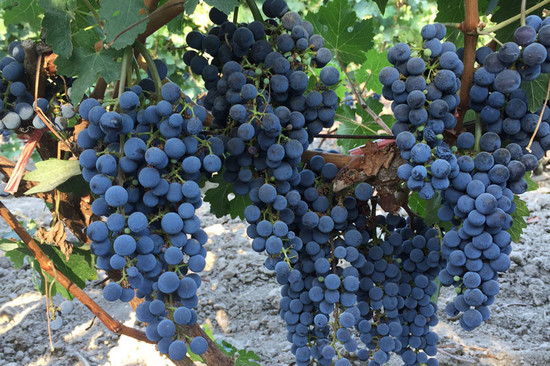
Image: Vineyard under careful management, Xinjiang, credit LI Demei
The Xinjiang Uyghur Autonomous Region
Xinjiang is China¡¯s biggest province; it is also the earliest wine region in China to plant vitis vinifera. The area¡¯s plantation of European grape varieties can be traced back to 2295 years ago.
With 140,000ha of grapes, Xinjiang is currently the biggest grape-planting province in China. 33,000ha of the plantings are supporting the region¡¯s annual 120,000 tons of raisin production; 43,000ha are seedless white grapes, part of which is sold as table grapes.
33,000ha of the total planting is for vitis vinefera. The 76 licenced local companies are producing 250m litres of wines. The rest 74,000 are table grapes.
Four regions are the key planting areas of wine grapes in Xinjiang: Tianshan Mountain North, Yanqi Basin, Turpan Basin and the Ili Valley.
As the biggest wine producing region in China, Xinjiang has a significant position in China¡¯s domestic wine industry.
The 2016 Xinjiang harvest
The 2016 wine harvest of Xinjiang has been a mixed success.
Xinjiang enjoys sufficient sunshine and vast day-night temperature variation, which are beneficial for the accumulation of sugar in fruits. The arid climate condition means that vineyards in Xinjiang are less prone to diseases, which is far more advantageous than the more humid and cloudy wine regions in Eastern China. The widely implemented drip-irrigation in vineyards in Xinjiang gives growers better control over the vigour of the vines.
However, as disease control isn¡¯t a constant concern, the growers are under the risk of a full-blown outbreak of diseases when occasional rainy weather hit the region.
During July and August of 2016, Xinjiang has experienced more rainfall than an average year, which has caused downy mildew and powdery mildew in some of the vineyards.
1. Tianshan Mountain North Region (North of Xinjiang)
In the Northern slope of the Tianshan Mountain, key vineyard planting areas are found from west to east in Shihezi, Manasi County, Hutubi County, Changji, Wujiaqu and Fukang. The region has 200,000mu (13,333ha) of wine grapes, the biggest continuous wine grape planting in the entire province. This region enjoys a comparatively moderate climate. The regular snow coverage in winter has been beneficial for vineyards to survive the severe winter in inland China.
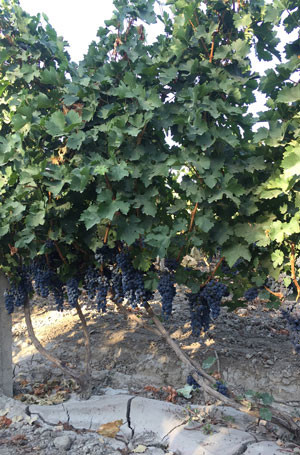
Image: Xinjiang vineyard under careful management, credit LI Demei
Shihezi
The majority of wine grapes produced in Shihezi are regularly purchased by Changyu, China¡¯s biggest wine producing company.
This year, white grape harvest started on 6th September in Shihezi, with red harvest starting ten days later. This year¡¯s harvest is expected to finish on 4th October, a date earlier than usual.
Manasi County
Grapes from the Manasi County are mainly sourced by CITIC Guoan Wine Co. Ltd. White harvest here started on 6th September; red harvest started only three days later, a week earlier than a regular year. The entire harvest is expected to finish on 30th September.
Wujiaqu
COFCO¡¯s Tianlu winery sources its grapes mainly from the city of Wujiaqu. White picking started on 9th September here. Red picking started on 20th and is expected to finish on 3rd October, again slightly earlier than usual.
Fukang
The vineyards in the city of Fukang are mainly owned by the CITIC Guoan Wine Co. Ltd. White and red grape harvest started on 13th and 17th of September respectively. The area expects the harvest to finish on 3rd or 4th October.
2. Yanqi Basin Region (South of Xinjiang)
The Yanqi Basin is situated on the mid-eastern area of Tianshan Mountain east. Grape producing areas are mainly found in the north of the Bayingolin Mongol Autonomous Prefecture, including Yanqi county, Hoxud County, Bohu [Bagrax] County, Hejing County, and the farmlands cultivated by the 24th and 223rd regiment of the Second Division of the Xinjiang Production and Construction Corps (XPCC).
China¡¯s biggest fresh water lake, the Bosten Lake, is situated in the region. The lake brings significant impact on the agricultural production in the region.
The region¡¯s nearly 200,000mu (13,333ha) of wine grapes are found mainly in the Yanqi County and the Hoxud County.
This is another arid region with less than 100mm rainfall every year. That combined with the extremely high sunshine hours and hot summers mean that the yields are low in the region, producing grapes of high sugar concentration.
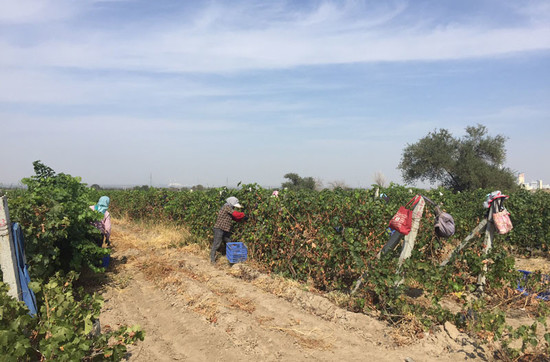
Image: Vineyards of the same region as the image above, but with less management, credit LI Demei
Hoxud County
The Hoxud County started the white harvest on 18th August. The rainfall in August and the subsequent wide-spread diseases have caused a reduction in yields. To make the situation worse, some wineries have reduced their purchase quantity of grapes due to the sluggish market. As a result, the majority of white grapes produced in the region were in fact abandoned.
Red grape harvest didn¡¯t start in most vineyards until 4th September. The harvest is still ongoing as of today (30th September), as 1/4 of the grapes is still due to be picked. In a more regular year, the harvest should have finished by mid-September.
Yanqi County
Similar to previous years, the Yanqi County started its white picking on 18th August and red on 26th. The majority of vineyards are picked a week later than usual here. The harvest is expected to finish by the end of September.
3. Turban Basin Region
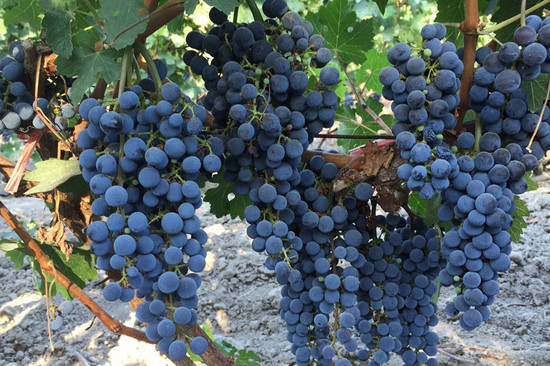
Image: Vineyard under careful management, Xinjiang, credit LI Demei
The 20,000mu (1,333ha) of wine grapes planted in Turban and Hami (Kumul) forms the Turban Basin Region.
Major planting areas include the Hongliuhe Horticultural Farm and Yiwanquan of the city of Turban, Shanshan County and the city of Hami.
Turban area
The Turban area started the harvest of seedless white grapes in mid-July for distilled liquor production. The picking of white grapes (for winemaking) started at the end of August; red variety picking didn¡¯t start until the beginning of September, later than the previous years. The harvest in this region has now been finished.
Shanshan County
Shanshan County started its white picking on 22nd August and reds on 6th September. The harvest is finished by now. This is also the first region in Xinjiang to plant wine grapes in the modern era, with the first vitis vinefera grapes planted in 1970s.
Hami (Kumul) area
The Hami area started its white harvest on 8th September and reds on 12th. The harvest is expected to finish by the end of September, earlier than previous years. This is also the only region in the Turban Basin Region to harvest early.
4. Ily Valley region
The wine grape vineyards along the Ily River are mainly cultivated by the 62, 63, 64, 67 and 70 regiment of the Xinjiang Production and Construction Corps (XPCC), accounting for 30,000mu (2000ha) of wine grapes.
This region enjoys cooler summers and more rainfall than the other Xinjiang wine regions. The harvest therefore started later¡ªnot until 25th September for the whites and 26th for the reds. The region expects to finish the harvest by mid-October, same as previous years.
Grapes meant for icewine production, however, will not be picked until early December.
Increased rainfall in August has caused wide-spread downy mildew in the region, before hail hit some of the vineyards. The local growers are expecting a 30% decrease in production.
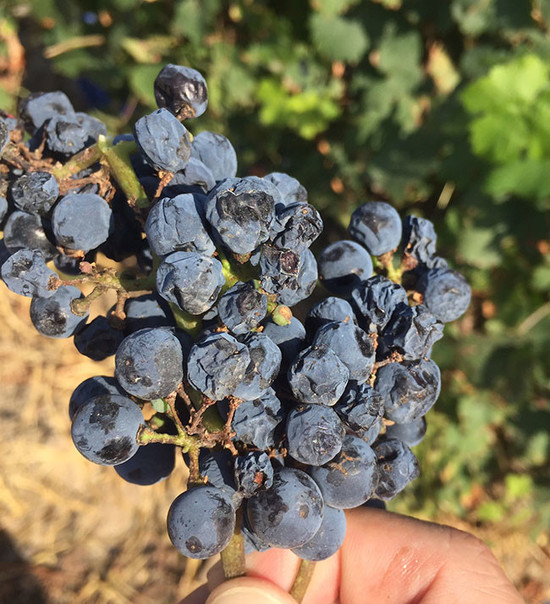
Image: Red grapes affected by rot, Xinjiang, credit LI Demei
To sum up
Generally speaking, in 2016 Xinjiang has seen more rainfall and lower average temperature.
For a region with abundant sunshine and warmth in growing season, these conditions have extended the growing period for grapes, therefore are beneficial for improving the quality of the fruit.
However, downy mildew and powdery mildew have ravaged vineyards that were less prepared for diseases, causing significant decrease in yields. Some Chardonnay and Syrah vineyards were affected by grey rots.
The 2016 vintage has been a mixed success for the wine growers in Xinjiang, as carefully managed and monitored vineyards are likely to achieve higher fruit quality than an average year. For producers less prepared for vineyard diseases, however, reduction in yields is almost inevitable.